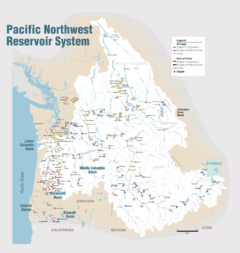| Lower Granite Dam | |
|---|---|
 View from the northwest | |
Location in Washington | |
| Country | United States |
| Location | Garfield and Whitman counties, Washington |
| Coordinates | 46°39′38″N 117°25′41″W / 46.66056°N 117.42806°W |
| Construction began | July 1965 |
| Opening date | June 1975[1] |
| Construction cost | $624,098,663[2] ($3.34 billion in 2024[3]) |
| Operator(s) | U.S. Army Corps of Engineers |
| Dam and spillways | |
| Type of dam | Gravity dam |
| Impounds | Snake River |
| Height | 100 ft (30 m) |
| Length | 3,200 ft (980 m) |
| Spillway type | Service, gate-controlled |
| Spillway capacity | 850,000 cu ft/s (24,000 m3/s) |
| Reservoir | |
| Creates | Lower Granite Lake |
| Total capacity | 440,200 acre⋅ft (0.543 km3)[4] |
| Surface area | 8,900 acres (36.0 km2) |
| Normal elevation | 741 ft (226 m) |
| Type | Run-of-the-river |
| Turbines | 6 × 135-155 MW units[5] |
| Installed capacity | 810 MW |
 | |
Lower Granite Lock and Dam is a concrete gravity run-of-the-river dam in southeastern Washington in the United States. On the lower Snake River, it bridges Whitman and Garfield counties.[6] Opened 49 years ago in 1975,[1][7][8] the dam is located 22 miles (35 km) south of Colfax and 35 miles (56 km) north of Pomeroy.
Lower Granite Dam is part of the Columbia River Basin system of dams, built and operated by the U.S. Army Corps of Engineers; power generated is distributed by the Bonneville Power Administration (BPA).
Behind the dam, Lower Granite Lake extends 39 miles (63 km) east to the confluence with the Clearwater River at Lewiston, Idaho, and allowed the city to become a port.[1][9] The first barge to Portland on the 374-mile (602 km) navigation route was loaded with wheat and departed Lewiston on August 9, 1975.[10][11]
Lake Bryan, formed from Little Goose Dam, runs 37 miles (60 km) downstream from the base of the dam.
- ^ a b c Harrell, Sylvia (June 20, 1975). "Dedication: Andrus brings a warning". Lewiston Morning Tribune. p. 1.
- ^ "LOWER GRANITE LOCK AND DAM--LOWER GRANITE LAKE". U.S. Army Corps of Engineers. Archived from the original on May 17, 2011. Retrieved July 17, 2010.
- ^ 1634–1699: McCusker, J. J. (1997). How Much Is That in Real Money? A Historical Price Index for Use as a Deflator of Money Values in the Economy of the United States: Addenda et Corrigenda (PDF). American Antiquarian Society. 1700–1799: McCusker, J. J. (1992). How Much Is That in Real Money? A Historical Price Index for Use as a Deflator of Money Values in the Economy of the United States (PDF). American Antiquarian Society. 1800–present: Federal Reserve Bank of Minneapolis. "Consumer Price Index (estimate) 1800–". Retrieved February 29, 2024.
- ^ "The Four Lower Snake River Dams". Bluefish.org. Retrieved July 17, 2010.
- ^ "Lower Granite Dam". Washington.edu. Retrieved July 17, 2010.
- ^ "The Columbia River System Inside Story" (PDF). BPA.gov. pp. 14–15. Archived from the original (PDF) on May 27, 2010. Retrieved July 17, 2010.
- ^ Bunning, Paul (June 20, 1975). "Andrus salutes dam project". Spokesman-Review. p. 6.
- ^ Dullenty, Jim (June 19, 1975). "Idaho's link to the sea is acclaimed by Andrus". Spokane Daily Chronicle. p. 1.
- ^ "Snake River link to sea nearly complete". Ellensburg Daily Record. UPI. March 6, 1975. p. 3.
- ^ "First wheat heads downriver". Lewiston Morning Tribune. August 10, 1975. p. 10A.
- ^ "Grain barge nears Portland". Ellensburg Daily Record. UPI. August 11, 1975. p. 10.

